Introduction to Management: Theories, Practices, and Analysis
VerifiedAdded on 2023/06/15
|5
|1458
|404
Essay
AI Summary
This essay provides an introduction to management, emphasizing the importance of managing businesses effectively amidst increasing complexities. It discusses the need for organizations to adapt to changes for better output and the role of management in coordinating efforts and formulating regulations. The essay highlights the significance of scientific management in dealing with business volatility and the importance of analyzing and predicting organizational behavior. It also touches upon the impact of the external business environment on managerial activities and the necessity of aligning changes with organizational goals. The essay further explores the principles of management and the importance of understanding the business scenario to achieve long-term organizational objectives, stressing the need for a systematic approach to attain effective results. Desklib provides access to this essay and a wealth of other solved assignments and past papers to support student learning.
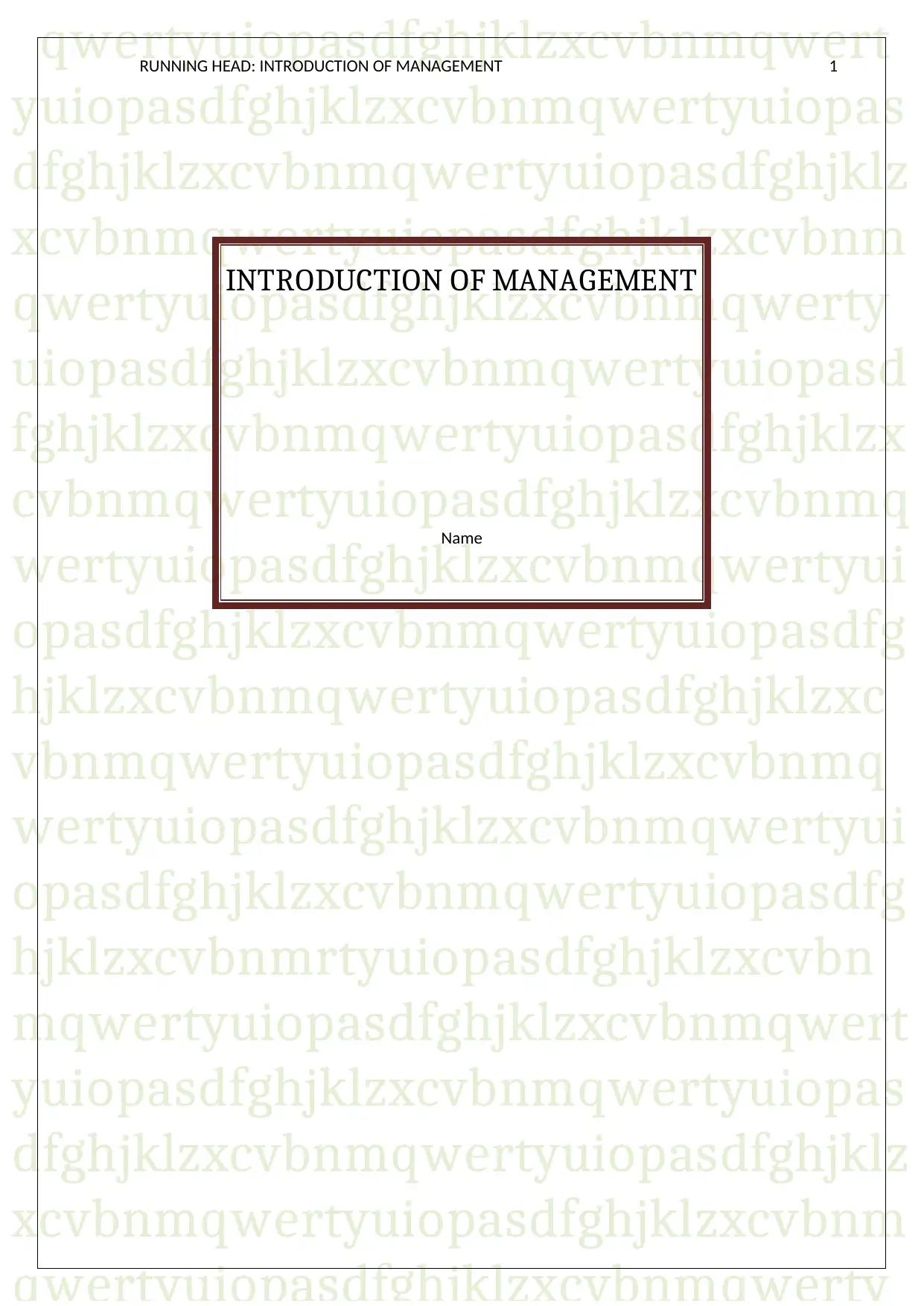
qwertyuiopasdfghjklzxcvbnmqwert
yuiopasdfghjklzxcvbnmqwertyuiopas
dfghjklzxcvbnmqwertyuiopasdfghjklz
xcvbnmqwertyuiopasdfghjklzxcvbnm
qwertyuiopasdfghjklzxcvbnmqwerty
uiopasdfghjklzxcvbnmqwertyuiopasd
fghjklzxcvbnmqwertyuiopasdfghjklzx
cvbnmqwertyuiopasdfghjklzxcvbnmq
wertyuiopasdfghjklzxcvbnmqwertyui
opasdfghjklzxcvbnmqwertyuiopasdfg
hjklzxcvbnmqwertyuiopasdfghjklzxc
vbnmqwertyuiopasdfghjklzxcvbnmq
wertyuiopasdfghjklzxcvbnmqwertyui
opasdfghjklzxcvbnmqwertyuiopasdfg
hjklzxcvbnmrtyuiopasdfghjklzxcvbn
mqwertyuiopasdfghjklzxcvbnmqwert
yuiopasdfghjklzxcvbnmqwertyuiopas
dfghjklzxcvbnmqwertyuiopasdfghjklz
xcvbnmqwertyuiopasdfghjklzxcvbnm
qwertyuiopasdfghjklzxcvbnmqwerty
RUNNING HEAD: INTRODUCTION OF MANAGEMENT 1
INTRODUCTION OF MANAGEMENT
Name
yuiopasdfghjklzxcvbnmqwertyuiopas
dfghjklzxcvbnmqwertyuiopasdfghjklz
xcvbnmqwertyuiopasdfghjklzxcvbnm
qwertyuiopasdfghjklzxcvbnmqwerty
uiopasdfghjklzxcvbnmqwertyuiopasd
fghjklzxcvbnmqwertyuiopasdfghjklzx
cvbnmqwertyuiopasdfghjklzxcvbnmq
wertyuiopasdfghjklzxcvbnmqwertyui
opasdfghjklzxcvbnmqwertyuiopasdfg
hjklzxcvbnmqwertyuiopasdfghjklzxc
vbnmqwertyuiopasdfghjklzxcvbnmq
wertyuiopasdfghjklzxcvbnmqwertyui
opasdfghjklzxcvbnmqwertyuiopasdfg
hjklzxcvbnmrtyuiopasdfghjklzxcvbn
mqwertyuiopasdfghjklzxcvbnmqwert
yuiopasdfghjklzxcvbnmqwertyuiopas
dfghjklzxcvbnmqwertyuiopasdfghjklz
xcvbnmqwertyuiopasdfghjklzxcvbnm
qwertyuiopasdfghjklzxcvbnmqwerty
RUNNING HEAD: INTRODUCTION OF MANAGEMENT 1
INTRODUCTION OF MANAGEMENT
Name
Paraphrase This Document
Need a fresh take? Get an instant paraphrase of this document with our AI Paraphraser
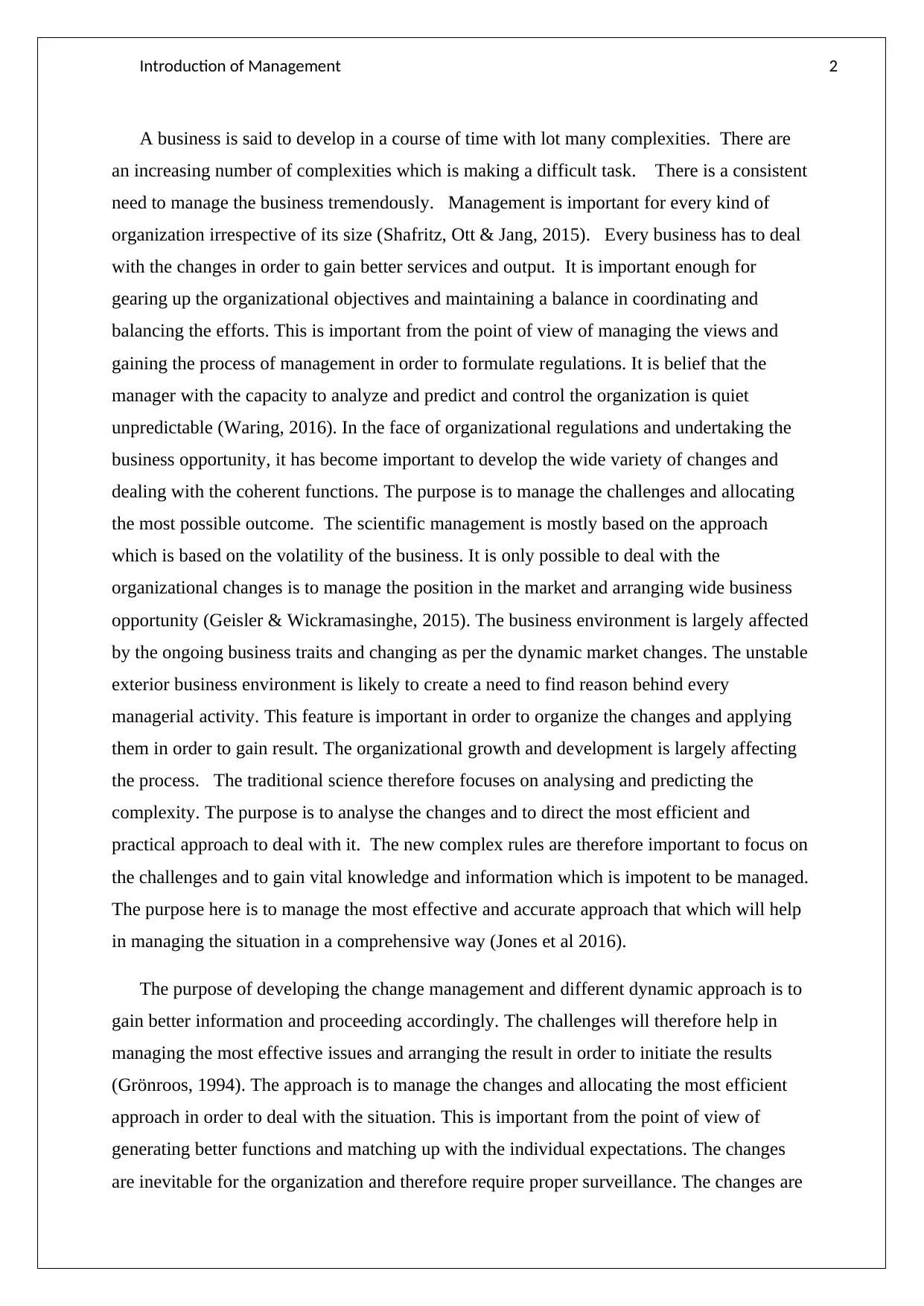
Introduction of Management 2
A business is said to develop in a course of time with lot many complexities. There are
an increasing number of complexities which is making a difficult task. There is a consistent
need to manage the business tremendously. Management is important for every kind of
organization irrespective of its size (Shafritz, Ott & Jang, 2015). Every business has to deal
with the changes in order to gain better services and output. It is important enough for
gearing up the organizational objectives and maintaining a balance in coordinating and
balancing the efforts. This is important from the point of view of managing the views and
gaining the process of management in order to formulate regulations. It is belief that the
manager with the capacity to analyze and predict and control the organization is quiet
unpredictable (Waring, 2016). In the face of organizational regulations and undertaking the
business opportunity, it has become important to develop the wide variety of changes and
dealing with the coherent functions. The purpose is to manage the challenges and allocating
the most possible outcome. The scientific management is mostly based on the approach
which is based on the volatility of the business. It is only possible to deal with the
organizational changes is to manage the position in the market and arranging wide business
opportunity (Geisler & Wickramasinghe, 2015). The business environment is largely affected
by the ongoing business traits and changing as per the dynamic market changes. The unstable
exterior business environment is likely to create a need to find reason behind every
managerial activity. This feature is important in order to organize the changes and applying
them in order to gain result. The organizational growth and development is largely affecting
the process. The traditional science therefore focuses on analysing and predicting the
complexity. The purpose is to analyse the changes and to direct the most efficient and
practical approach to deal with it. The new complex rules are therefore important to focus on
the challenges and to gain vital knowledge and information which is impotent to be managed.
The purpose here is to manage the most effective and accurate approach that which will help
in managing the situation in a comprehensive way (Jones et al 2016).
The purpose of developing the change management and different dynamic approach is to
gain better information and proceeding accordingly. The challenges will therefore help in
managing the most effective issues and arranging the result in order to initiate the results
(Grönroos, 1994). The approach is to manage the changes and allocating the most efficient
approach in order to deal with the situation. This is important from the point of view of
generating better functions and matching up with the individual expectations. The changes
are inevitable for the organization and therefore require proper surveillance. The changes are
A business is said to develop in a course of time with lot many complexities. There are
an increasing number of complexities which is making a difficult task. There is a consistent
need to manage the business tremendously. Management is important for every kind of
organization irrespective of its size (Shafritz, Ott & Jang, 2015). Every business has to deal
with the changes in order to gain better services and output. It is important enough for
gearing up the organizational objectives and maintaining a balance in coordinating and
balancing the efforts. This is important from the point of view of managing the views and
gaining the process of management in order to formulate regulations. It is belief that the
manager with the capacity to analyze and predict and control the organization is quiet
unpredictable (Waring, 2016). In the face of organizational regulations and undertaking the
business opportunity, it has become important to develop the wide variety of changes and
dealing with the coherent functions. The purpose is to manage the challenges and allocating
the most possible outcome. The scientific management is mostly based on the approach
which is based on the volatility of the business. It is only possible to deal with the
organizational changes is to manage the position in the market and arranging wide business
opportunity (Geisler & Wickramasinghe, 2015). The business environment is largely affected
by the ongoing business traits and changing as per the dynamic market changes. The unstable
exterior business environment is likely to create a need to find reason behind every
managerial activity. This feature is important in order to organize the changes and applying
them in order to gain result. The organizational growth and development is largely affecting
the process. The traditional science therefore focuses on analysing and predicting the
complexity. The purpose is to analyse the changes and to direct the most efficient and
practical approach to deal with it. The new complex rules are therefore important to focus on
the challenges and to gain vital knowledge and information which is impotent to be managed.
The purpose here is to manage the most effective and accurate approach that which will help
in managing the situation in a comprehensive way (Jones et al 2016).
The purpose of developing the change management and different dynamic approach is to
gain better information and proceeding accordingly. The challenges will therefore help in
managing the most effective issues and arranging the result in order to initiate the results
(Grönroos, 1994). The approach is to manage the changes and allocating the most efficient
approach in order to deal with the situation. This is important from the point of view of
generating better functions and matching up with the individual expectations. The changes
are inevitable for the organization and therefore require proper surveillance. The changes are
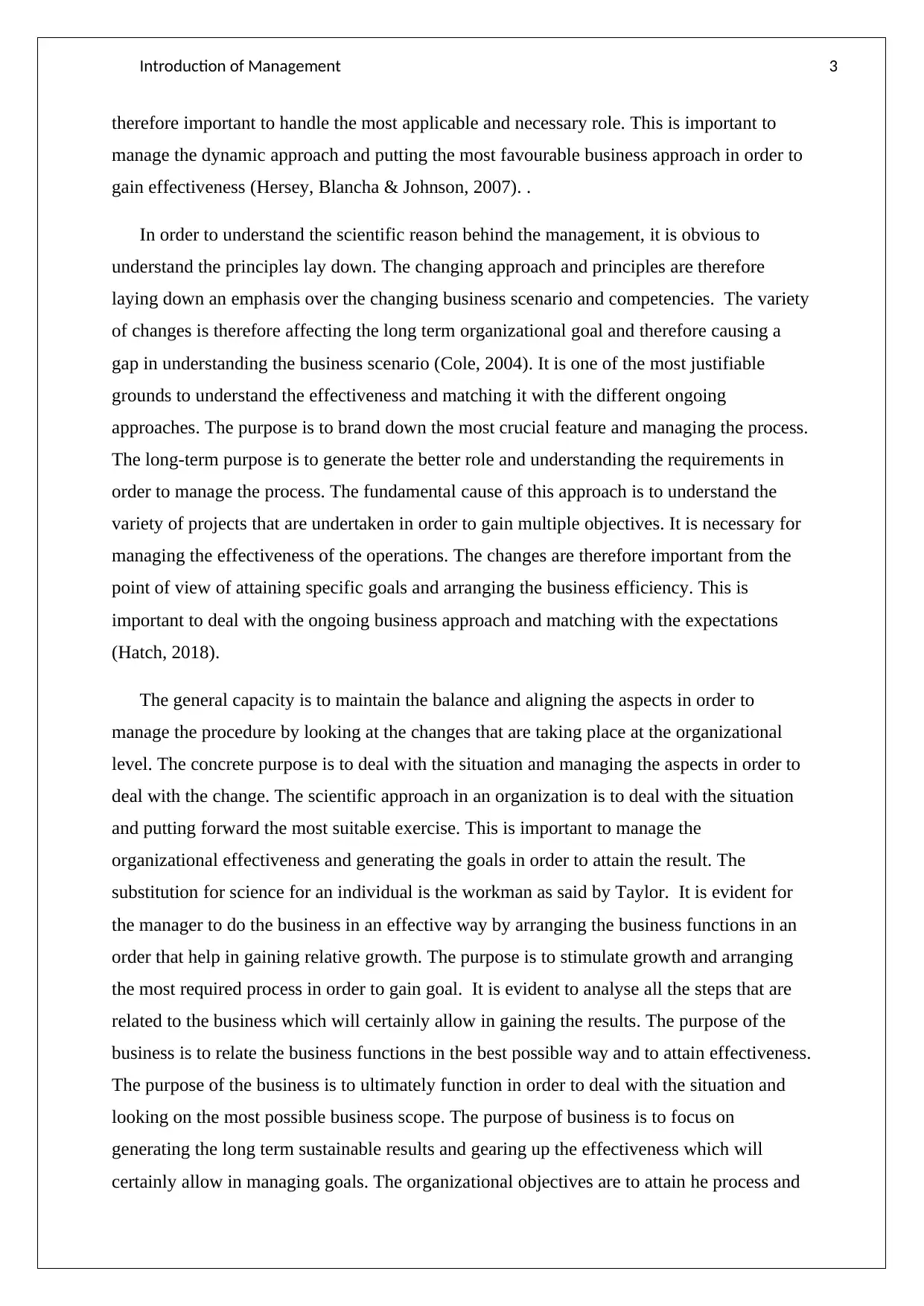
Introduction of Management 3
therefore important to handle the most applicable and necessary role. This is important to
manage the dynamic approach and putting the most favourable business approach in order to
gain effectiveness (Hersey, Blancha & Johnson, 2007). .
In order to understand the scientific reason behind the management, it is obvious to
understand the principles lay down. The changing approach and principles are therefore
laying down an emphasis over the changing business scenario and competencies. The variety
of changes is therefore affecting the long term organizational goal and therefore causing a
gap in understanding the business scenario (Cole, 2004). It is one of the most justifiable
grounds to understand the effectiveness and matching it with the different ongoing
approaches. The purpose is to brand down the most crucial feature and managing the process.
The long-term purpose is to generate the better role and understanding the requirements in
order to manage the process. The fundamental cause of this approach is to understand the
variety of projects that are undertaken in order to gain multiple objectives. It is necessary for
managing the effectiveness of the operations. The changes are therefore important from the
point of view of attaining specific goals and arranging the business efficiency. This is
important to deal with the ongoing business approach and matching with the expectations
(Hatch, 2018).
The general capacity is to maintain the balance and aligning the aspects in order to
manage the procedure by looking at the changes that are taking place at the organizational
level. The concrete purpose is to deal with the situation and managing the aspects in order to
deal with the change. The scientific approach in an organization is to deal with the situation
and putting forward the most suitable exercise. This is important to manage the
organizational effectiveness and generating the goals in order to attain the result. The
substitution for science for an individual is the workman as said by Taylor. It is evident for
the manager to do the business in an effective way by arranging the business functions in an
order that help in gaining relative growth. The purpose is to stimulate growth and arranging
the most required process in order to gain goal. It is evident to analyse all the steps that are
related to the business which will certainly allow in gaining the results. The purpose of the
business is to relate the business functions in the best possible way and to attain effectiveness.
The purpose of the business is to ultimately function in order to deal with the situation and
looking on the most possible business scope. The purpose of business is to focus on
generating the long term sustainable results and gearing up the effectiveness which will
certainly allow in managing goals. The organizational objectives are to attain he process and
therefore important to handle the most applicable and necessary role. This is important to
manage the dynamic approach and putting the most favourable business approach in order to
gain effectiveness (Hersey, Blancha & Johnson, 2007). .
In order to understand the scientific reason behind the management, it is obvious to
understand the principles lay down. The changing approach and principles are therefore
laying down an emphasis over the changing business scenario and competencies. The variety
of changes is therefore affecting the long term organizational goal and therefore causing a
gap in understanding the business scenario (Cole, 2004). It is one of the most justifiable
grounds to understand the effectiveness and matching it with the different ongoing
approaches. The purpose is to brand down the most crucial feature and managing the process.
The long-term purpose is to generate the better role and understanding the requirements in
order to manage the process. The fundamental cause of this approach is to understand the
variety of projects that are undertaken in order to gain multiple objectives. It is necessary for
managing the effectiveness of the operations. The changes are therefore important from the
point of view of attaining specific goals and arranging the business efficiency. This is
important to deal with the ongoing business approach and matching with the expectations
(Hatch, 2018).
The general capacity is to maintain the balance and aligning the aspects in order to
manage the procedure by looking at the changes that are taking place at the organizational
level. The concrete purpose is to deal with the situation and managing the aspects in order to
deal with the change. The scientific approach in an organization is to deal with the situation
and putting forward the most suitable exercise. This is important to manage the
organizational effectiveness and generating the goals in order to attain the result. The
substitution for science for an individual is the workman as said by Taylor. It is evident for
the manager to do the business in an effective way by arranging the business functions in an
order that help in gaining relative growth. The purpose is to stimulate growth and arranging
the most required process in order to gain goal. It is evident to analyse all the steps that are
related to the business which will certainly allow in gaining the results. The purpose of the
business is to relate the business functions in the best possible way and to attain effectiveness.
The purpose of the business is to ultimately function in order to deal with the situation and
looking on the most possible business scope. The purpose of business is to focus on
generating the long term sustainable results and gearing up the effectiveness which will
certainly allow in managing goals. The organizational objectives are to attain he process and
⊘ This is a preview!⊘
Do you want full access?
Subscribe today to unlock all pages.

Trusted by 1+ million students worldwide
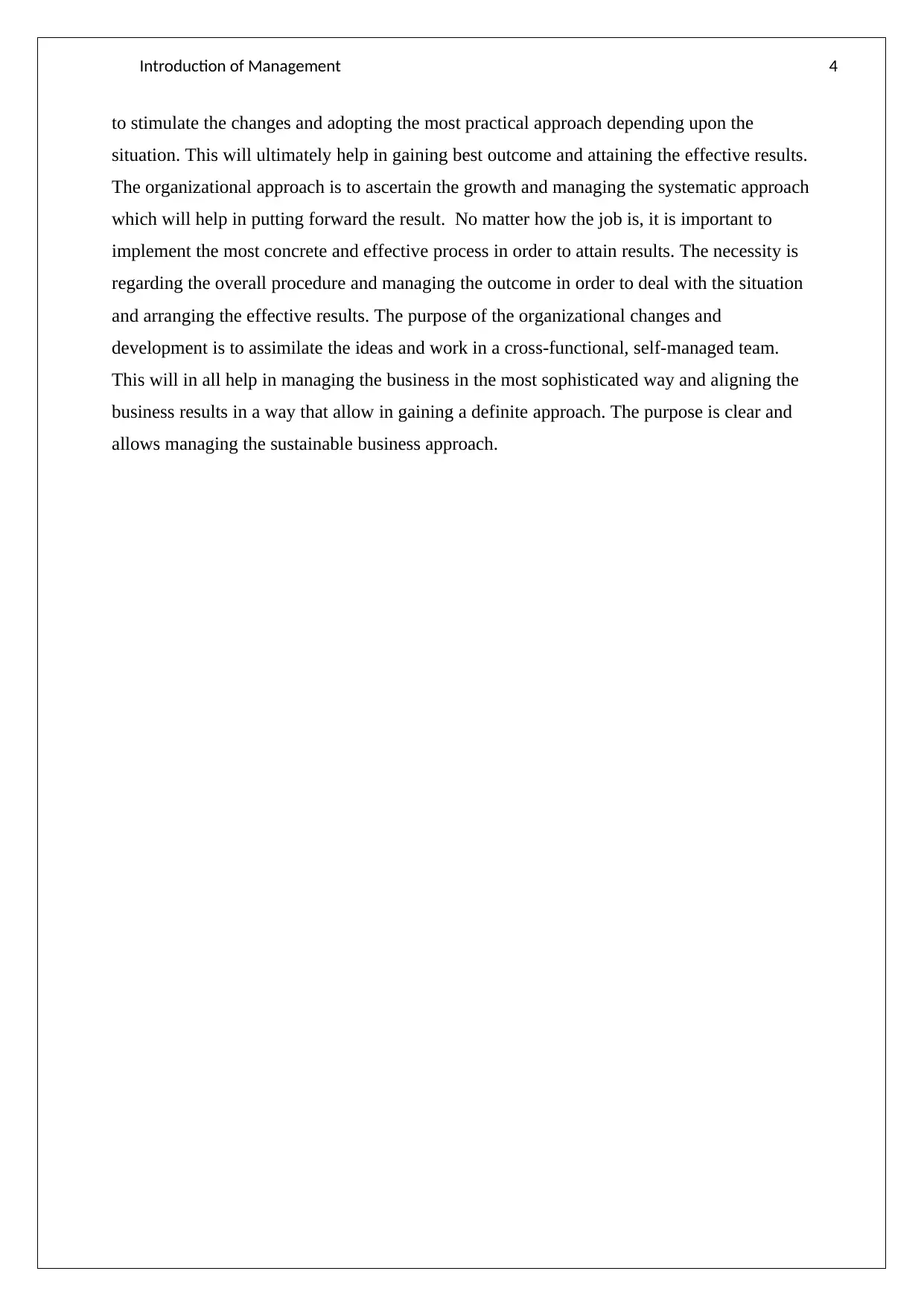
Introduction of Management 4
to stimulate the changes and adopting the most practical approach depending upon the
situation. This will ultimately help in gaining best outcome and attaining the effective results.
The organizational approach is to ascertain the growth and managing the systematic approach
which will help in putting forward the result. No matter how the job is, it is important to
implement the most concrete and effective process in order to attain results. The necessity is
regarding the overall procedure and managing the outcome in order to deal with the situation
and arranging the effective results. The purpose of the organizational changes and
development is to assimilate the ideas and work in a cross-functional, self-managed team.
This will in all help in managing the business in the most sophisticated way and aligning the
business results in a way that allow in gaining a definite approach. The purpose is clear and
allows managing the sustainable business approach.
to stimulate the changes and adopting the most practical approach depending upon the
situation. This will ultimately help in gaining best outcome and attaining the effective results.
The organizational approach is to ascertain the growth and managing the systematic approach
which will help in putting forward the result. No matter how the job is, it is important to
implement the most concrete and effective process in order to attain results. The necessity is
regarding the overall procedure and managing the outcome in order to deal with the situation
and arranging the effective results. The purpose of the organizational changes and
development is to assimilate the ideas and work in a cross-functional, self-managed team.
This will in all help in managing the business in the most sophisticated way and aligning the
business results in a way that allow in gaining a definite approach. The purpose is clear and
allows managing the sustainable business approach.
Paraphrase This Document
Need a fresh take? Get an instant paraphrase of this document with our AI Paraphraser
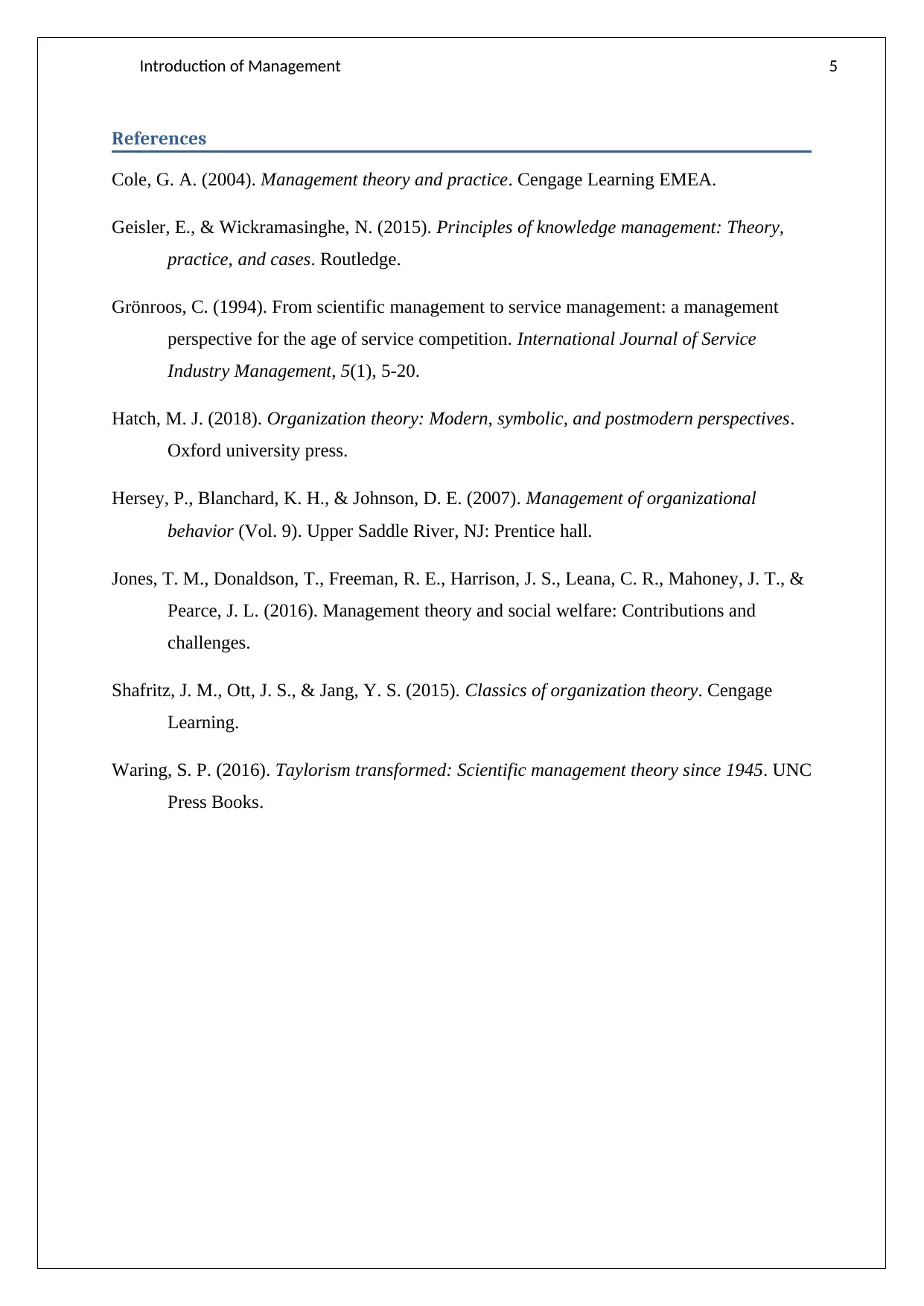
Introduction of Management 5
References
Cole, G. A. (2004). Management theory and practice. Cengage Learning EMEA.
Geisler, E., & Wickramasinghe, N. (2015). Principles of knowledge management: Theory,
practice, and cases. Routledge.
Grönroos, C. (1994). From scientific management to service management: a management
perspective for the age of service competition. International Journal of Service
Industry Management, 5(1), 5-20.
Hatch, M. J. (2018). Organization theory: Modern, symbolic, and postmodern perspectives.
Oxford university press.
Hersey, P., Blanchard, K. H., & Johnson, D. E. (2007). Management of organizational
behavior (Vol. 9). Upper Saddle River, NJ: Prentice hall.
Jones, T. M., Donaldson, T., Freeman, R. E., Harrison, J. S., Leana, C. R., Mahoney, J. T., &
Pearce, J. L. (2016). Management theory and social welfare: Contributions and
challenges.
Shafritz, J. M., Ott, J. S., & Jang, Y. S. (2015). Classics of organization theory. Cengage
Learning.
Waring, S. P. (2016). Taylorism transformed: Scientific management theory since 1945. UNC
Press Books.
References
Cole, G. A. (2004). Management theory and practice. Cengage Learning EMEA.
Geisler, E., & Wickramasinghe, N. (2015). Principles of knowledge management: Theory,
practice, and cases. Routledge.
Grönroos, C. (1994). From scientific management to service management: a management
perspective for the age of service competition. International Journal of Service
Industry Management, 5(1), 5-20.
Hatch, M. J. (2018). Organization theory: Modern, symbolic, and postmodern perspectives.
Oxford university press.
Hersey, P., Blanchard, K. H., & Johnson, D. E. (2007). Management of organizational
behavior (Vol. 9). Upper Saddle River, NJ: Prentice hall.
Jones, T. M., Donaldson, T., Freeman, R. E., Harrison, J. S., Leana, C. R., Mahoney, J. T., &
Pearce, J. L. (2016). Management theory and social welfare: Contributions and
challenges.
Shafritz, J. M., Ott, J. S., & Jang, Y. S. (2015). Classics of organization theory. Cengage
Learning.
Waring, S. P. (2016). Taylorism transformed: Scientific management theory since 1945. UNC
Press Books.
1 out of 5
Related Documents
Your All-in-One AI-Powered Toolkit for Academic Success.
+13062052269
info@desklib.com
Available 24*7 on WhatsApp / Email
![[object Object]](/_next/static/media/star-bottom.7253800d.svg)
Unlock your academic potential
Copyright © 2020–2025 A2Z Services. All Rights Reserved. Developed and managed by ZUCOL.





